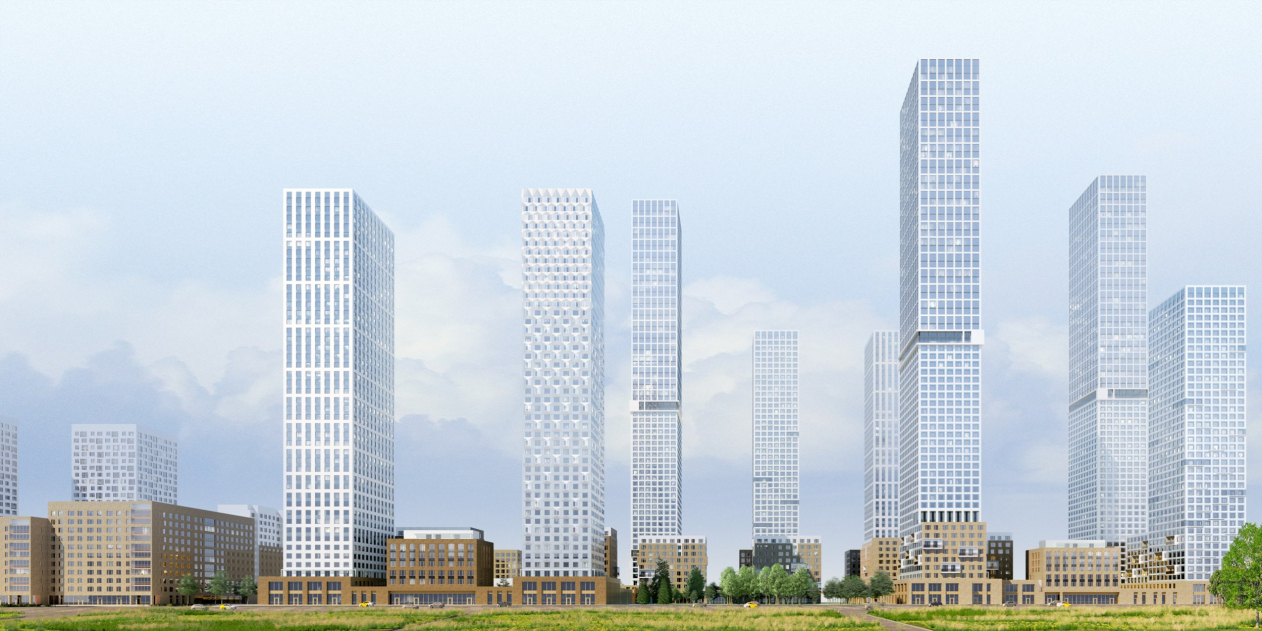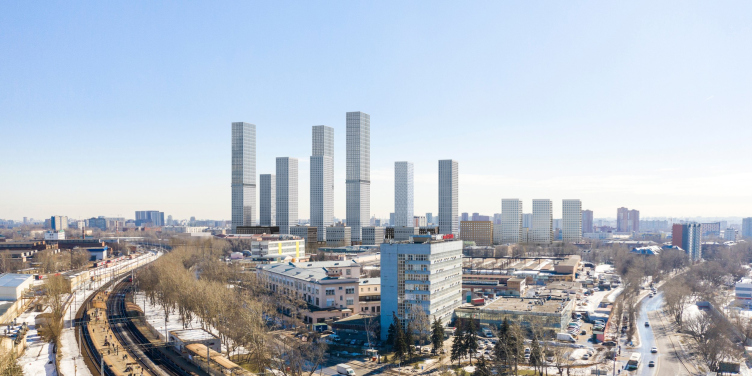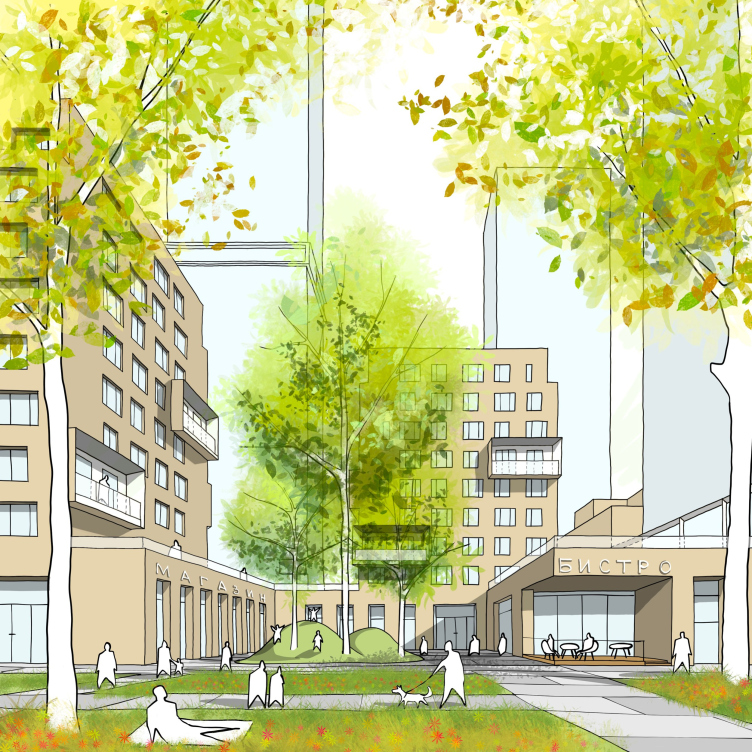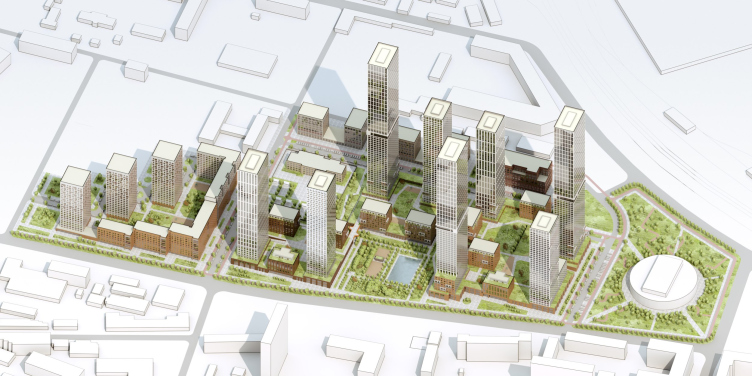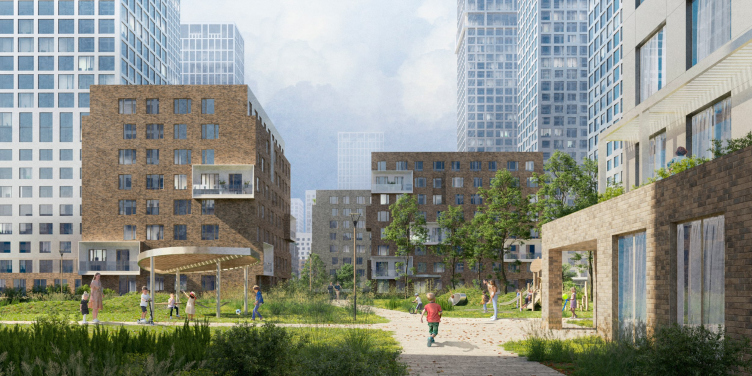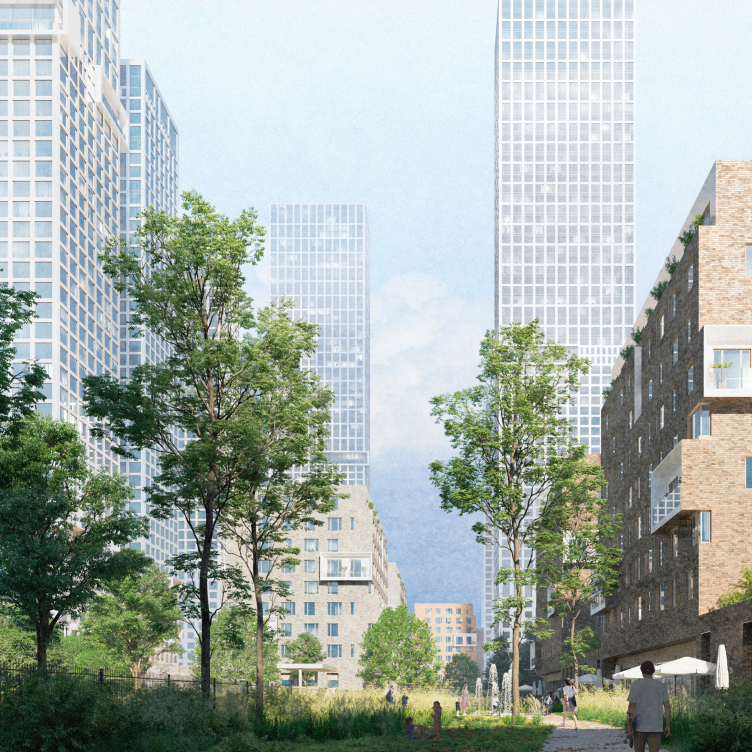Architectural and town planning concept of developing the territory of Stankoagregat plant
Copyright: © OSA architects
The Nizhegorodsky District, in which the land site is situated, is considered to be one of the most industrialized ones in the capital. This automatically means that it is not really fit for housing construction: scattered all over the territory, the industrial facilities not only pollute the air but also make a lot of noise, complicate the transportation and pedestrian communication between the districts, and get in the way of creating green and public spaces.
Stankoagregat plant is part of the Karacharovo industrial park, delineated by a triangle of railways, whose three sides border on large industrial parks “Graivoronovo”, “Serp i Molot”, and the Moscow Train Engine Repair Plant. On the outside, the block pushes against yet another triangle, this time consisting of highways – the Ryazansky Avenue, the Northeast Chord, and a fragment of the Southwest Chord (to be built later on).
Nevertheless, despite all these challenges, the territory is gradually transforming and becoming more and more interesting to the investors. Yet another impulse for further development was provided by the construction of the Nizhegorodskaya transportation hub, which is already in operation, but will be fully completed by 2024. Next to it, on the other side of the Ryazansky Avenue, shopping malls and housing complexes are being built: Sreda with a linear park, “Quarters 21/19”, “Aquilon BESIDE”, “Profit”, and “Perovskoe 2”. Some of the territories are also eligible for the program of housing stock renovation.
Architectural and town planning concept of developing the territory of Stankoagregat plant
Copyright: © OSA architects
The complex built by Level Group, as was already said, will be constructed in the very heart of Karacharovo, on the territory of Stankoagregat plant – an enterprise that took an active part in implementing the first Soviet five-year plan, and was pronounced bankrupt in 2018. The land site is surrounded by warehouses and facilities whose days are probably numbered, as well as by residential buildings of the 1950’s and 1960’e, many of which will be demolished under the housing stock renovation program. When completed, the Level Group will trigger a full makeover of the industrial zone into a residential area, and the architects not so much inscribed the buildings into the context as thought out the strategy of developing Karacharovo in a new capacity.
Architectural and town planning concept of developing the territory of Stankoagregat plant
Copyright: © OSA architects
Architectural and town planning concept of developing the territory of Stankoagregat plant
Copyright: © OSA architects
Therefore, the concept proposed by OSA goes beyond the confines of the site owned by the client. The adjacent western territory, located across the designed street, is planned for renovation. Here, the architects are proposing a composition of three towers and a sectional “slab” house: such a pattern is better suited for the size of the apartments designed under this program; it also highlights the construction of the main site. The solution was developed on the basis of participation in the competition “Oblik Renovatsii” (“Renovation Image”) – the company is on the winner list on the Golyanovo and Amurskaya sites.
From the opposite side, the crossing of several streets created a reason for placing here some kind of conspicuous public building – in a densely packed area as this one, a Public Service Center or a Health and Fitness complex, surrounded by trees, would be appropriate. Currently, the site hosts a few industrial facilities.
Architectural and town planning concept of developing the territory of Stankoagregat plant
Copyright: © OSA architects
All the three sites lying on the outer contour are united by a broad green street that plays the part of the public city space here. This street is faced by mid-rise sections of the co-livings, included in the technical specifications, most of the businesses on the first floors, as well as a spacious park. The landscape of the park gets large-size coniferous and deciduous trees integrated into it, as well as a monument to the factory workers who died during the Second World War. The list of new projects also includes a man-made pond, playgrounds, and sports facilities. It was expected that the park would be landscaped simultaneously with the construction of the first stage of the housing complex, placing the sales office into it, which later on would be made over into a pavilion.
Vitaliy Zuev, Chief Architect of the Project
I consider our proposal for a park connecting the two high-rise complexes to be a local success of our project. This solution not only meets the urban planning requirements for the site regarding the presence of a “natural complex” of the specified size, but also gives the future district a unique public space. This is made possible thanks to the the location of the park on the site and its sheer size.
Architectural and town planning concept of developing the territory of Stankoagregat plant
Copyright: © OSA architects
And finally, regarding the plan of the main site, the architects from the very beginning developed the idea of combining towers and mid-rise sections. Such a model allows you to solve a whole number of tasks: to form comfortable spaces between the houses, give the complex an interesting silhouette, and achieve greater diversity of the housing typology, as well as to make sure that the overloaded Petrovsky Highway is faced by as few facades as possible.
On the whole, the combination of towers and mid-rise buildings very successfully combines the comfort of urban spaces with high density of construction, due to typological diversity, versatility, and scale. We also try to implement such patterns in mass housing in other regions of Russia, of course, adjusted for the actual number of floors and construction density. The results of this competition gave us even more confidence in this idea.
Architectural and town planning concept of developing the territory of Stankoagregat plant
Copyright: © OSA architects
Eight towers 46 and 68 stories high (150 and 220 meters respectively) are placed in a freehand fashion along the perimeter of the site, forming views that work best from a distance. The stylobate part connects the towers and urban villas, delineating the boundaries of the system of transparent city blocks. In the space created by these blocks, one can clearly read a more habitual mid-rise scale of construction – this happens due to the textured decoration material and the sculptural design of the urban villas, and also due to the architects’ decision to push the towers away from the stylobate contour. The terraced “foothills” are brought in the foreground, and are offset by the backdrop of the “mountain peaks” of the high-rises with their rhythmic facade pattern. The freehand placement of the towers leaves the sky unobstructed, letting the sun peek into every corner of the block.
Architectural and town planning concept of developing the territory of Stankoagregat plant
Copyright: © OSA architects
As for the high density of the complex, the architects are planning to offset it with spaces between the houses. Private yards with a landscape similar to a natural one are placed on the roofs of the stylobates, connected by overpasses. The sites that are vacant from underground structures are turned into shady boulevards – open to city people, they make the blocks more transparent. The land planning project also includes a site for a kindergarten for 250 kids. The northern part also includes inbuilt kindergartens, placed upon the stylobates.
Architectural and town planning concept of developing the territory of Stankoagregat plant
Copyright: © OSA architects
The selection of apartments was specially developed for two types of towers and varied from studios to four-room apartments with an area of 106.8 square meters. The urban villas only account for 20% of the total housing space: they are a “reserve” that will give the developer an opportunity to adjust to the realities of the ever-changing market, adding unusual typologies: houses with open terraces, little gardens, or an individual exit to the boulevard.
The perimeter of the first floor of the stylobate is occupied by commercial premises, lobbies, and entrance groups of the inbuilt kindergartens; further on, there will be parking spaces. The underground floors will also include parking spaces, elevator halls, maintenance rooms, and utility hubs. The entrance to the territory of the complex is made from the streets; each of the sections can be accessed by local driveways or via the underground parking garage.

